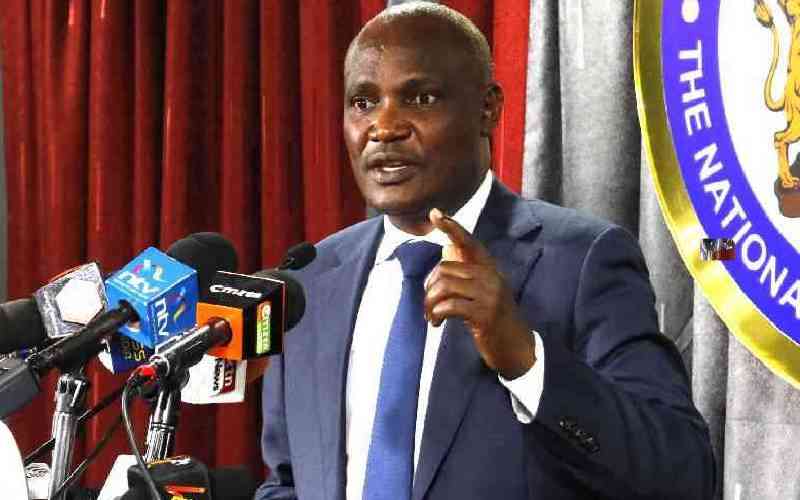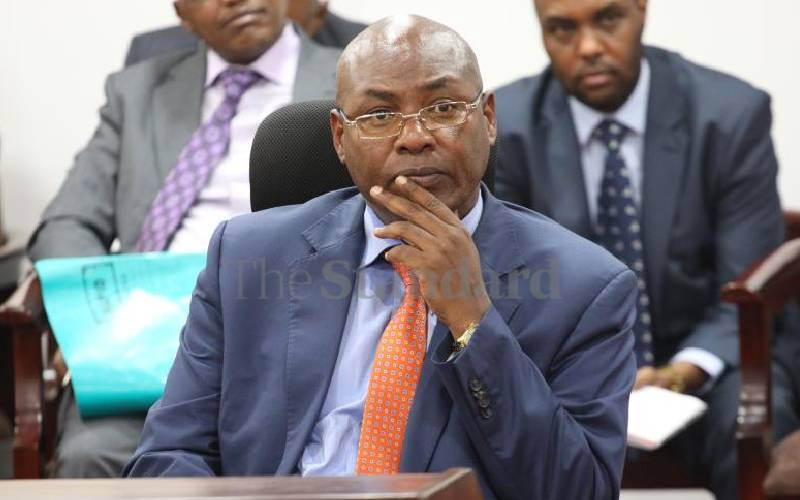 |
|
Pallbearers carry the casket of founding President Jomo Kenyatta. |
By JOSEPH KARIMI
Before his death on August 22, 1978, founding President Jomo Kenyatta suffered a number of health scares that were kept secret from the public.
Several times, the Head of State slipped into a coma, which he said were visits to a place of wide, open plains he called Weru wa Mukaaga.
In his memoirs, Kenya’s first black governor of the Central Bank, Duncan Ndegwa, tells of Kenyatta’s comas that left top government officials scrambling to resuscitate the Head of State.
One day, Kenyatta “suffered a blackout at his Mombasa Tiririka residence, and remained in a coma for three days. They were three days of uncertainty and when he came out of it I was among the first people to visit him,” writes Ndegwa in Walking in Kenyatta’s Struggles: My Story.
“I asked him what had happened. He replied that he had visited what he called Weru wa Mukaaga, meaning an expansive plain where he was all alone. Kenyata recalled that one could not see the end of that serene plain, where he had been at complete peace and where the sun never set... Kenyatta toured Weru wa Mukaaga on other occasions, but the final one was on August 22, 1978, when he went, never to return”.
It was a normal day like any other until around midday when a telex was sent to the newsroom announcing the death. I was then a deputy news editor at one of the local dailies.
Generally, we kept track of the president’s movements. He was down at the coast for his routine “working holiday.” The President had left Nakuru on July 29, for Mombasa, with a brief stopover in Nairobi. He then travelled by road to Mombasa and it was understood he avoided air travel due to his health woes.
At around noon, Hassanali, our Telex operator brought a strip of paper to the news editor. It was a terse official government announcement: “President Jomo Kenyatta died early this morning in his sleep at State House Mombasa......”
The shocking news paralysed the entire newsroom with everybody wanting to see the telex strip for himself. We immediately planned for a special edition that afternoon.
No one had handled such a situation before, and there was a lot of anxiety. The official announcement from State House, Nairobi, said: “Mzee died in his sleep at 3.30am at State House, Mombasa...The President, who was also Commander –in-Chief of the Armed Forces, passed away peacefully. The Government requests all Kenyans to remain calm at this moment of national shock. All flags are to fly at half mast.”
From the window of the newsroom, it was business as usual on the streets below, but not for long. As soon as the Voice of Kenya (now Kenya Broadcasting Corporation) went on air with the bulletin, the public was caught unawares. Kenya without Kenyatta was unthinkable.
People hurriedly retreated from the streets as they assumed something chaotic would result. Most Kenyans did not contemplate Kenyatta dying despite his advanced age. Many collapsed while others burst into screams. It could not be imagined the President would ever die!
Ailing President
Some businesses shut hurriedly. Small groups gathered haphazard here and there, but the situation was under control.
Stay informed. Subscribe to our newsletter
The announcement said Vice-President Moi would exercise the functions of the Office of the President. Kenya was in shock.
The biggest question lingering in people’s minds all the way from 1974 when Kenyatta suffered a mild stroke was “After Kenyatta, what?”
Since the 1974 General Elections, Kenyatta was sickly with reported heart problems and mild stroke. The government authority apparently had devolved into three centres of power, one kind of mobile under Kenyatta and Mbiyu Koinange, the other based at Harambee House under Geoffrey Kariithi as Secretary to the Cabinet and Head of the Civil Service, and the third based in Nakuru.
A raging political campaign orchestrated under the “Change of Constitution” campaign by the likes of former Member of Parliament Dickson Mihika Kimani aimed at stopping Moi from automatically taking over the presidency, had created political uncertainty in the succession during the last four years of Kenyatta’s rule. The power struggle heightened this anxiety.
Treason
It was during this time that former Attorney General Charles Njonjo famously said it was treason to even imagine the death of a sitting president. Yet, now, Kenyatta’s body lay at State House, Nairobi.
It emerged in later years that entry to State House was tightly controlled to avoid confusion and possibly illegal claims to leadership.
State officials handled the matter secretly and first transported the body to State House Nairobi, before the official announcement was made. Shortly after, the body was embalmed. It was Provincial Commissioner Eliud Mahihu who arranged the body’s airlift to Nairobi.
Moi, Cabinet Ministers and Permanent Secretaries gathered at State House for an impromptu meeting to strategise. Njonjo was at the helm guiding them on the Constitution. Teaming up with Geoffrey Kariithi, then Head of the Civil Service and Secretary to the Cabinet, both announced to Kenyans the 90-day interim period that Moi would lead as acting president, as the country awaited elections, in accordance with the Constitution.
Meanwhile, a high profile funeral committee was quickly formed with Karugu Nganatha as coordinator.
A Nairobi architect George Vamos was picked to design the 34 feet square Mausoleum and G Campagnola Ltd awarded the contract. A government directive was issued from the Office of the President suspending all public meetings including harambee meetings through the 30-day mourning period. All nightspots, including nightclubs were silenced. A quick check to see whether the order was being observed revealed that some of these entertainment spots had never closed their doors since opening.
Owners who were adhering to the directives took advantage to clean layers of dirt from their floors, which had accumulated dust and grime for years. From Thursday, August 24, until Wednesday August 30, the State House gates remained open to the public to facilitate the viewing of Mzee’s body lying in State. Thousands of people from all walks of life filed past to pay their last respects to the Grand Old Man of Africa. Throughout the week, starting 9am to 5pm, two long queues formed within the precincts of State House.
Kikuyu Traditions
With my special media pass, I was able to enter and leave State House at will. Smartly dressed, Kenyatta’s body lay with his walking stick and the fly-whisk, the symbols of his authority, at his side. It was estimated that half a million people viewed the body.
Somehow, Kenya was brought together by the death. Jaramogi Oginga Odinga, Kenyatta’s former Vice President accompanied by members of his family stopped beside the body and offered prayers: “May his soul rest in eternal peace. Let us follow his example,” Odinga said, and wept. The two were bitter rivals.
On Wednesday, on the eve of the State funeral, Mzee’s body was moved to his Gatundu home for a night stay in accordance with Kikuyu traditions.
 The Standard Group Plc is a
multi-media organization with investments in media platforms spanning newspaper
print operations, television, radio broadcasting, digital and online services. The
Standard Group is recognized as a leading multi-media house in Kenya with a key
influence in matters of national and international interest.
The Standard Group Plc is a
multi-media organization with investments in media platforms spanning newspaper
print operations, television, radio broadcasting, digital and online services. The
Standard Group is recognized as a leading multi-media house in Kenya with a key
influence in matters of national and international interest.
 The Standard Group Plc is a
multi-media organization with investments in media platforms spanning newspaper
print operations, television, radio broadcasting, digital and online services. The
Standard Group is recognized as a leading multi-media house in Kenya with a key
influence in matters of national and international interest.
The Standard Group Plc is a
multi-media organization with investments in media platforms spanning newspaper
print operations, television, radio broadcasting, digital and online services. The
Standard Group is recognized as a leading multi-media house in Kenya with a key
influence in matters of national and international interest.









